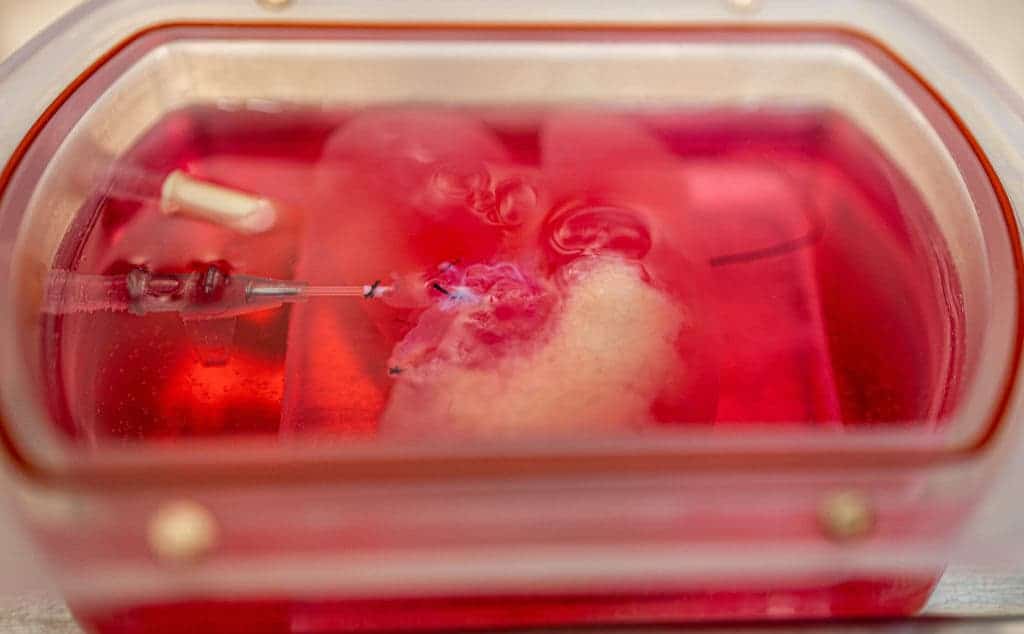Researchers at the University of Pittsburgh (Pitt) School of Medicine have successfully grown miniature human livers in the lab.

Photograph of rat liver, stripped of rat-specific cells and re-seeded with engineered human liver cells.
Image credits UPMC.
The genetically-modified diminutive organs are meant to be a test platform for scientists to simulate human liver disease progression and test therapies on. As a proof of concept, the Pitt team created one such miniliver that mimics non-alcoholic fatty liver disease (NAFLD).
DeLivering on demand
“This is the first time we can create genetically engineered human mini livers with a disease using stem cells in the lab,” said senior author Alejandro Soto-Gutierrez, Ph.D. and associate professor of pathology at Pitt’s School of Medicine.
The team creates their tiny livers by genetically-engineering human skin cells. These cells are programmed to simulate a certain disease, are then reverted back to their stem state, and then made to mature into fully-functional liver cells.
For the current paper, the team modified the cells to express a chemically activated switch that could clamp down the on SIRT1 gene (SIRT1 proteins are commonly associated with NAFLD). After turning these cells into liver cells, the researchers seeded them into rat livers (which were previously stripped of their own cells). The implanted cells matured into functional 3-D mini livers, with the blood vessels and other structural features of a normal organ.
The organ mimics non-alcoholic fatty liver disease (NAFLD), a condition which can lead to cirrhosis or even liver failure. NAFLD is quickly becoming the leading cause of chronic liver disease in the United States due to its association with obesity.
The team says that their mini livers offer researchers a unique platform to understand not just a disease and how it progresses, but also for the testing of therapeutics. It’s common for drugs to fail in clinical trials despite promising results in mice, they explain, citing the drug Resveratrol. Resveratrol acts on SIRT1, and it was effective in mouse models for the treatment of NAFLD but failed in human clinical trials.
“Mice aren’t humans,” Soto-Gutierrez said. “We are born with certain mutations, polymorphisms, that will predispose us to certain diseases, but you can’t study polymorphisms in mice, so making a mini customized human liver is advantageous.”
What sets the mini livers apart from ‘organoid‘ cultures — bundles of cells that self-assemble into simple versions of organs — is the presence of those structural features such as blood vessels, the team explains. However, they caution that the mini livers “lack the distinct zones of metabolic function” that normal livers have.
Once they fully matured, the team flipped the genetic switch they programmed into the cells (to suppress the SIRT1 gene) and the mini livers started to mimic the metabolic dysfunction observed in tissues NAFLD patients. Just like in the clinical trials, Resveratrol wasn’t effective on these livers, either.
However, the mini livers did allow the team to figure out what went wrong. Resveratrol boosts the activity of SIRT1 proteins not SIRT1 genes. When SIRT1 gene expression is suppressed, such as is the case with the micro livers and perhaps also NAFLD patients, there isn’t any protein to act on. The drug doesn’t work because it’s targeting the wrong step.
“That’s an insight that could only come from studying functional human tissue,” Soto-Gutierrez said.
“I imagine in the future we can make human livers where you can order what kind of function you want, or even enhance function.”
However, we’re a long way away from that point. These mini livers won’t be ready for clinical applications like transplantation anytime soon, Soto-Gutierrez adds.
The paper “Generation of Human Fatty Livers Using Custom-Engineered Induced Pluripotent Stem Cells with Modifiable SIRT1 Metabolism” has been published in the journal Cell Metabolism.









